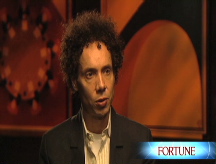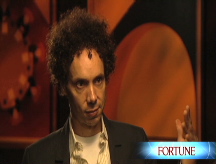Secrets of their success
What separates the legendary CEO from the chronically dissatisfied cubicle dweller? It's not innate talent, argues Tipping Point author Malcolm Gladwell in his new book.
 |
| Malcolm Gladwell's new book demystifies the "outliers." |
 |
| P&G and Goldman are good examples of companies that think talent should be something you develop, not something you acquire, says Gladwell. |
(Fortune Magazine) -- In the business world, managing talent is one of those topics that are both overanalyzed and misunderstood. What separates the legendary CEO from the chronically dissatisfied cubicle dweller?
In his provocative new book, Outliers: The Story of Success (Little Brown), Malcolm Gladwell makes the case that the answer isn't innate talent. New Yorker writer Gladwell, also author of The Tipping Point and Blink, sat down with Fortune to talk about Bill Gates' lucky break, why Asians are good at math, and why some of us aren't destined for success - but still can make it big.
Fortune: What exactly is an outlier?
Gladwell: It's a technical term for a phenomenon that is outside normal experience. Scientists use it all the time when they are graphing data. You've got a nice little bell curve, and then you have a couple of things that are way out here. Well, this book is about people who are way out there.
F: How did you become interested in this topic?
G: I was interested in writing about success. I just became convinced that our explanations [of what drives it] were lacking. We have the kind of self-made-man myth, which says that super-successful people did it themselves. And we have a series of other beliefs that say that our personality, our intelligence, all of our innate characteristics are the primary driving force. It's that cluster of things that I don't agree with.
The premise of this book is that you can learn a lot more about success by looking around at the successful person, at what culture they belong to, what their parents did for a living. Successful people are people who have made the most of a series of gifts that have been given to them by their culture or their history, by their generation.
F: Talk about Bill Gates. The mythology is that he was spontaneously drawn to computers. But you say that's not the case.
G: Bill Gates has this utterly extraordinary series of opportunities. When he's 13, it's 1969. He shows up at his private school in Seattle, and they have a computer room with a teletype machine that is hooked up to a mainframe downtown. Anyone who was playing on the teletype machine could do real-time programming. Ninety-nine percent of the universities in America in 1969 did not have that.
Then, when he was 15 or so, classmate Paul Allen learned that there was a mainframe at the University of Washington that was not being used between two and six every morning. So they would get up at 1:30 in the morning, walk a mile, and program for four hours. When Gates is 20, he has as much experience as people who have spent their entire lives being programmers. He has this incredible headstart.
F: What link does practice have to success?
G: The 10,000-hours rule says that if you look at any kind of cognitively complex field, from playing chess to being a neurosurgeon, we see this incredibly consistent pattern that you cannot be good at that unless you practice for 10,000 hours, which is roughly ten years, if you think about four hours a day.
F: You also talk a lot about culture. How does it affect math skills, for example?
G: We give kids from around the world the same set of math tests, and every time we get the same results: America is just below average, and then at the very, very top are Singapore, Hong Kong, Japan, South Korea, and Taiwan. It occurs again and again.
There's an ultimately unconvincing argument that this has to do with IQ. I think what it has to do with is culture. Asian culture has a profoundly different relationship to work. It rewards people who are persistent.
Take a random group of 8-year-old American and Japanese kids, give them all a really, really hard math problem, and start a stopwatch. The American kids will give up after 30, 40 seconds. If you let the test run for 15 minutes, the Japanese kids will not have given up. You have to take it away.
I argue that this has to do with the kind of agriculture pursued in the West and the East going back thousands of years. I have ancestors who were peasant farmers in Western Europe in the Middle Ages. They probably worked 1,000 hours a year, if that. In the winter, they slept. They drank a lot of beer.
These Asian cultures are all wet-rice agricultural economies. Growing rice is this extraordinarily complex, labor-intensive activity that requires not just physical engagement but mental engagement. So a farmer in 14th-century Japan or 14th-century China was working 3,000 hours a year - three times longer. I know it sounds hard to believe, but habits laid down by our ancestors persist even after the conditions that created those habits have gone away.
F: You share a fascinating story about culture and airline safety.
G: Korean Air had more plane crashes than almost any other airline in the world for a period at the end of the 1990s. When we think of airline crashes, we think, Oh, they must have had old planes. They must have had badly trained pilots. No. What they were struggling with was a cultural legacy, that Korean culture is hierarchical. You are obliged to be deferential toward your elders and superiors in a way that would be unimaginable in the U.S.
But Boeing (BA, Fortune 500) and Airbus design modern, complex airplanes to be flown by two equals. That works beautifully in low-power-distance cultures [like the U.S., where hierarchies aren't as relevant]. But in cultures that have high power distance, it's very difficult.
I use the case study of a very famous plane crash in Guam of Korean Air. They're flying along, and they run into a little bit of trouble, the weather's bad. The pilot makes an error, and the co-pilot doesn't correct him. But once Korean Air figured out that their problem was cultural, they fixed it.
F: So let's broaden this out. Are there lessons in this book that are applicable to the business world?
G: Yes. Instead of thinking about talent as something that you acquire, talent should be thought of as something that you develop. Procter & Gamble (PG, Fortune 500) is a great example of a company that does that and has prospered as a result. Look around Wall Street, or what's left of it today, and you'll see lots and lots and lots of people from Goldman Sachs (GS, Fortune 500). That's not a coincidence. It's because they took their mission to invest in people seriously.
F: Should people be expected to take the issue of developing talent seriously right now, in the middle of a crisis?
G: Paradoxically, this might be the perfect time. When it's easy to make money, you have no incentive to think about development of talent. Now, you're forced to. At least that's my optimistic hope. ![]()
-
 The retail giant tops the Fortune 500 for the second year in a row. Who else made the list? More
The retail giant tops the Fortune 500 for the second year in a row. Who else made the list? More -
 This group of companies is all about social networking to connect with their customers. More
This group of companies is all about social networking to connect with their customers. More -
 The fight over the cholesterol medication is keeping a generic version from hitting the market. More
The fight over the cholesterol medication is keeping a generic version from hitting the market. More -
 Bin Laden may be dead, but the terrorist group he led doesn't need his money. More
Bin Laden may be dead, but the terrorist group he led doesn't need his money. More -
 U.S. real estate might be a mess, but in other parts of the world, home prices are jumping. More
U.S. real estate might be a mess, but in other parts of the world, home prices are jumping. More -
 Libya's output is a fraction of global production, but it's crucial to the nation's economy. More
Libya's output is a fraction of global production, but it's crucial to the nation's economy. More -
 Once rates start to rise, things could get ugly fast for our neighbors to the north. More
Once rates start to rise, things could get ugly fast for our neighbors to the north. More










